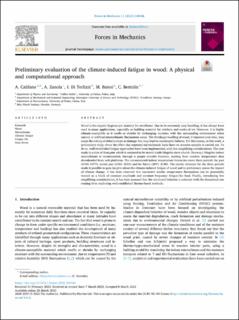| dc.contributor.author | Califano, Andrea | |
| dc.contributor.author | Zanola, A. | |
| dc.contributor.author | Di Terlizzi, Terlizzi | |
| dc.contributor.author | Baiesi, M. | |
| dc.contributor.author | Bertolin, Chiara | |
| dc.date.accessioned | 2023-10-11T10:42:07Z | |
| dc.date.available | 2023-10-11T10:42:07Z | |
| dc.date.created | 2023-04-11T13:18:57Z | |
| dc.date.issued | 2023 | |
| dc.identifier.citation | Forces in Mechanics. 2023, 11 . | en_US |
| dc.identifier.uri | https://hdl.handle.net/11250/3095771 | |
| dc.description.abstract | Wood is the organic hygroscopic material for excellence. Due to its extremely easy handling, it has always been used in many applications, especially as building material for artefacts and works of art. However, it is highly climate-susceptible as it swells or shrinks by exchanging moisture with the surrounding environment when natural or artificial microclimatic fluctuations occur. The shrinkage/swelling of wood, if repeated over time, may cause the arising of deformations or damage that may lead to catastrophic failures. For this reason, in this work, a preliminary study about the effect that repeated microclimatic loads have on wooden samples is carried out. To do so, well-established fatigue approaches have been implemented, with few simplifying considerations. The case study is a slice of Scots pine which is assumed to be stored inside Ringebu stave church (Norway). Ringebu indoor microclimate is reconstructed, through a proper transfer function, starting from outdoor temperature data downloaded from web platforms. The reconstructed indoor temperature timeseries cover three periods: far past (1948–1977), recent past (1981–2010) and far future (2071–2100). The results obtained for the three periods made it possible to gain insights about the climate-induced fatigue of wood and to preliminary assess the impact of climate change. It has been observed that successive similar temperature fluctuations can be potentially treated as a block of constant amplitude and constant frequency fatigue-like load. Finally, introducing few simplifying considerations, it has been assessed that the simulated behavior is coherent with the theoretical one coming from exploiting well-established thermo-based methods. | en_US |
| dc.language.iso | eng | en_US |
| dc.publisher | Elsevier B. V. | en_US |
| dc.rights | Attribution-NonCommercial-NoDerivatives 4.0 Internasjonal | * |
| dc.rights.uri | http://creativecommons.org/licenses/by-nc-nd/4.0/deed.no | * |
| dc.title | Preliminary evaluation of the climate-induced fatigue in wood: A physical and computational approach | en_US |
| dc.title.alternative | Preliminary evaluation of the climate-induced fatigue in wood: A physical and computational approach | en_US |
| dc.type | Peer reviewed | en_US |
| dc.type | Journal article | en_US |
| dc.description.version | publishedVersion | en_US |
| dc.source.volume | 11 | en_US |
| dc.source.journal | Forces in Mechanics | en_US |
| dc.identifier.doi | 10.1016/j.finmec.2023.100186 | |
| dc.identifier.cristin | 2139979 | |
| dc.source.articlenumber | 100186 | en_US |
| cristin.ispublished | true | |
| cristin.fulltext | original | |
| cristin.qualitycode | 1 | |

